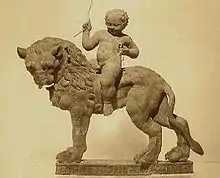Qataban
Qataban or Katabania (Arabic: مملكة قتبان; Qatabanian: 𐩤𐩩𐩨𐩬) was an ancient Yemeni kingdom. Its heartland was located in the Baihan valley. Like some other Southern Arabian kingdoms it gained great wealth from the trade of frankincense and myrrh, incenses which were burned at altars. The capital of Qataban was named Timna and was located on the trade route which passed through the other kingdoms of Hadramaut, Sheba and Ma'in. The chief deity of the Qatabanians was 'Amm, or "Uncle", and the people called themselves the "children of Amm".

Bronze lion with a rider made by the Qatabanians circa 75-50 BCE.
It was a prominent Yemeni kingdom in the 2nd half of the 1st millennium BCE, when its ruler held the title of the South Arabian hegemon Mukarrib.
Bibliography
- Alessandro de Maigret. Arabia Felix, translated Rebecca Thompson. London: Stacey International, 2002. ISBN 1-900988-07-0
- Andrey Korotayev. Ancient Yemen. Oxford: Oxford University Press, 1995. ISBN 0-19-922237-1.
- Andrey Korotayev. Pre-Islamic Yemen. Wiesbaden: Harrassowitz Verlag, 1996. ISBN 3-447-03679-6.
- Andrey Korotayev. Socio-Political Conflict in the Qatabanian Kingdom? (A re-interpretation of the Qatabanic inscription R 3566) // Proceedings of the Seminar for Arabian Studies 27 (1997): 141–158.
This article is issued from Wikipedia. The text is licensed under Creative Commons - Attribution - Sharealike. Additional terms may apply for the media files.
